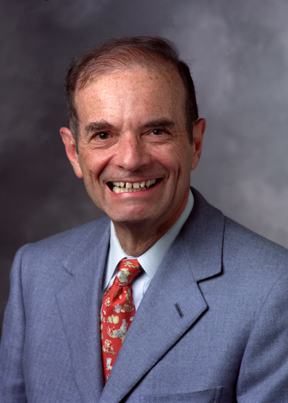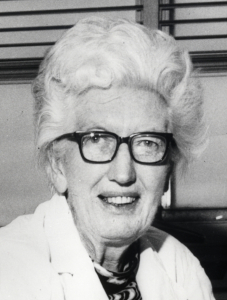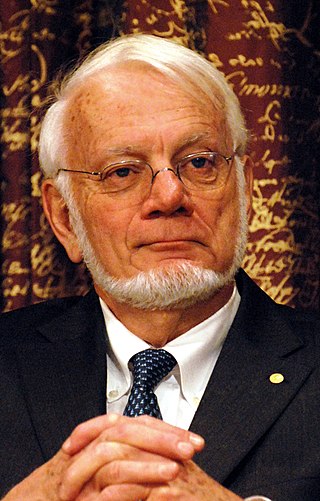Related Research Articles

Robert G. Roeder is an American biochemist. He is known as a pioneer scientist in eukaryotic transcription. He discovered three distinct nuclear RNA polymerases in 1969 and characterized many proteins involved in the regulation of transcription, including basic transcription factors and the first mammalian gene-specific activator over five decades of research. He is the recipient of the Gairdner Foundation International Award in 2000, the Albert Lasker Award for Basic Medical Research in 2003, and the Kyoto Prize in 2021. He currently serves as Arnold and Mabel Beckman Professor and Head of the Laboratory of Biochemical and Molecular Biology at The Rockefeller University.
Abraham Adrian Albert was an American mathematician. In 1939, he received the American Mathematical Society's Cole Prize in Algebra for his work on Riemann matrices. He is best known for his work on the Albert–Brauer–Hasse–Noether theorem on finite-dimensional division algebras over number fields and as the developer of Albert algebras, which are also known as exceptional Jordan algebras.

Guard cells are specialized plant cells in the epidermis of leaves, stems and other organs that are used to control gas exchange. They are produced in pairs with a gap between them that forms a stomatal pore. The stomatal pores are largest when water is freely available and the guard cells become turgid, and closed when water availability is critically low and the guard cells become flaccid. Photosynthesis depends on the diffusion of carbon dioxide (CO2) from the air through the stomata into the mesophyll tissues. Oxygen (O2), produced as a byproduct of photosynthesis, exits the plant via the stomata. When the stomata are open, water is lost by evaporation and must be replaced via the transpiration stream, with water taken up by the roots. Plants must balance the amount of CO2 absorbed from the air with the water loss through the stomatal pores, and this is achieved by both active and passive control of guard cell turgor pressure and stomatal pore size.

Lubert Stryer was an American academic who was the Emeritus Mrs. George A. Winzer Professor of Cell Biology, at Stanford University School of Medicine. His research over more than four decades had been centered on the interplay of light and life. In 2007 he received the National Medal of Science from President Bush at a ceremony at the White House for elucidating the biochemical basis of signal amplification in vision, pioneering the development of high density microarrays for genetic analysis, and authoring the standard undergraduate biochemistry textbook, Biochemistry. It is now in its tenth edition and also edited by Jeremy Berg, Justin Hines, John L. Tymoczko and Gregory J. Gatto, Jr.

Berta Vogel Scharrer was an American scientist who helped to found the scientific discipline now known as neuroendocrinology.

Thomas Bill Kornberg is an American biochemist who was the first person to purify and characterise DNA polymerase II and DNA polymerase III. He is currently a professor of biochemistry and biophysics at the University of California, San Francisco, and is working on Drosophila melanogaster development.

Gail Roberta Martin is an American biologist. She is professor emerita in the Department of Anatomy, University of California, San Francisco. She is known for her pioneering work on the isolation of pluripotent stem cells from normal embryos, for which she coined the term 'embryonic stem cells'. She is widely recognized for her work on the function of fibroblast growth factors and their negative regulators in vertebrate organogenesis. She and her colleagues made contributions to gene targeting technology.
George Karreman was a Dutch-born US physicist, mathematical biophysicist and mathematical/theoretical biologist. He was the first president of the Society for Mathematical Biology (SMB).

Thomas Arthur Steitz was an American biochemist, a Sterling Professor of Molecular Biophysics and Biochemistry at Yale University, and investigator at the Howard Hughes Medical Institute, best known for his pioneering work on the ribosome.

Warren Jackson Pledger is a molecular cell biologist who is the Associate Director for Basic Sciences, Tampa General Hospital Cancer Institute and Professor, Department of Molecular Medicine, Morsani College of Medicine, USF Health in Tampa, Florida. He had been a Professor, Department of Surgery, University of Utah School of Medicine and a member of the Cell Response and Regulation Program, Huntsman Cancer Institute. He was the Associate Center Director for Basic Science at the Moffitt Cancer Center and Research Institute. He has held academic appointments and tenure at the University of North Carolina School of Medicine, Vanderbilt University School of Medicine and the University of South Florida College of Medicine.

G. Marius Clore MAE, FRSC, FMedSci, FRS is a British-born, Anglo-American molecular biophysicist and structural biologist. He was born in London, U.K. and is a dual U.S./U.K. Citizen. He is a Member of the National Academy of Sciences, a Fellow of the Royal Society, a Fellow of the Academy of Medical Sciences, a Fellow of the American Academy of Arts and Sciences, a NIH Distinguished Investigator, and the Chief of the Molecular and Structural Biophysics Section in the Laboratory of Chemical Physics of the National Institute of Diabetes and Digestive and Kidney Diseases at the U.S. National Institutes of Health. He is known for his foundational work in three-dimensional protein and nucleic acid structure determination by biomolecular NMR spectroscopy, for advancing experimental approaches to the study of large macromolecules and their complexes by NMR, and for developing NMR-based methods to study rare conformational states in protein-nucleic acid and protein-protein recognition. Clore's discovery of previously undetectable, functionally significant, rare transient states of macromolecules has yielded fundamental new insights into the mechanisms of important biological processes, and in particular the significance of weak interactions and the mechanisms whereby the opposing constraints of speed and specificity are optimized. Further, Clore's work opens up a new era of pharmacology and drug design as it is now possible to target structures and conformations that have been heretofore unseen.

Roger Morgan Spanswick was a Professor of Biological and Environmental Engineering at Cornell University and an important figure in the history of plant membrane biology.

Peter Klock Hepler HonFRMS is the Constantine J. Gilgut and Ray Ethan Torrey Professor Emeritus in the Biology Department of the University of Massachusetts at Amherst who is notable for his work on elucidating the roles of calcium, membranes and the cytoskeleton in plant cell development and cell motility.
Robert L. Last is a plant biochemical genomicist who studies metabolic processes that protect plants from the environment and produce products important for animal and human nutrition. His research has covered (1) production and breakdown of essential amino acids, (2) the synthesis and protective roles of Vitamin C and Vitamin E (tocopherols) as well as identification of mechanisms that protect photosystem II from damage, and (3) synthesis and biological functions of plant protective specialized metabolites. Four central questions are: (i) how are leaf and seed amino acids levels regulated, (ii.) what mechanisms protect and repair photosystem II from stress-induced damage, (iii.) how do plants produce protective metabolites in their glandular secreting trichomes (iv.) and what are the evolutionary mechanisms that contribute to the tremendous diversity of specialized metabolites that protect plants from insects and pathogens and are used as therapeutic agents.
David Domingo Sabatini is an Argentine-American cell biologist and the Frederick L. Ehrman Professor Emeritus of Cell Biology in the Department of Cell Biology at New York University School of Medicine, which he chaired from 1972 to 2011. Sabatini's major research interests have been on the mechanisms responsible for the structural complexity of the eukaryotic cell. Throughout his career, Sabatini has been recognized for his efforts in promoting science in Latin America.

Yorgo E. Modis is Professor in Virology and Immunology, and a Wellcome Trust Senior Research Fellow at the Department of Medicine, University of Cambridge. He is head of The Modis Lab in the Molecular Immunity Unit at the MRC Laboratory of Molecular Biology. He studies cellular mechanisms of viral gene sensing and silencing. His group employs a diverse set of complementary biophysical approaches including cryo-electron microscopy (cryoEM), X-ray crystallography, solution biophysics, fluorescence microscopy and cell biological approaches to understand the cellular mechanisms of viral gene sensing and silencing in molecular-level detail.
Jian-Kang Zhu is a plant scientist, researcher and academic. He is a Senior Principal Investigator in the Shanghai Center for Plant Stress Biology, Chinese Academy of Sciences (CAS). He is also the Academic Director of CAS Center of Excellence in Plant Sciences.

Patrick J. (Pat) Casey is a biochemist and molecular pharmacologist and is a James B. Duke Professor of Pharmacology and Cancer Biology at Duke University School of Medicine. In 2005, he relocated to Singapore to help found the Duke-NUS Medical School Singapore, where he served as its Senior Vice Dean of Research through July, 2023.
Alfred Tissières was a Swiss molecular biologist, a pioneer in highlighting the role of ribosomes in protein biosynthesis and the initiator of studies on heat shock proteins synthesized by cells subjected to stress. He shared the Marcel Benoist Prize with Edouard Kellenberger in 1966.
References
- ↑ "University of Cambridge Academic: Jim Haseloff / Julian Hibberd / Roger Leigh / Enid MacRobbie". plant-biology.com.
- ↑ https://www.girton.cam.ac.uk/people/professor-enid-macrobbie [ bare URL ]
- 1 2 3 4 5 "Women Pioneers in Plant Biology / Biographies: Enid MacRobbie". American Society of Plant Biologists. Archived from the original on 3 December 2003.